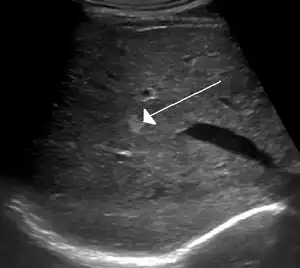Cavernous liver hemangioma
A cavernous liver hemangioma or hepatic hemangioma is a benign tumor of the liver composed of hepatic endothelial cells. It is the most common benign liver tumour, and is usually asymptomatic and diagnosed incidentally on radiological imaging. Liver hemangiomas are thought to be congenital in origin.[1] Several subtypes exist, including the giant hepatic haemangioma, which can cause significant complications.
| Cavernous liver hemangioma | |
|---|---|
 | |
| Hemangioma of the liver as seen on ultrasound | |
| Specialty | Oncology |
Diagnosis
Liver hemangiomas are typically hyperechoic on ultrasound though may occasionally be hypoechoic; ultrasound is not diagnostic. Computed tomography (CT),[2] magnetic resonance imaging (MRI)[3] or single-photon emission computed tomography (SPECT) using autologous labelled Red Blood Cells (RBC) with Tc-99m is diagnostic. Biopsy is avoided due to the risk of haemorrhage.
Hepatic hemangiomas can occur as part of a clinical syndrome, for example Klippel–Trénaunay syndrome, Osler–Weber–Rendu syndrome and Von Hippel–Lindau syndrome.
Types
- Typical hepatic hemangioma
- Atypical hepatic hemangioma
- Giant hepatic hemangioma
- Flash filling hepatic hemangioma – can account for up to 16% of all hepatic hemangiomas
- Calcified hepatic hemangioma
- Hyalinized hepatic hemangioma
- Other unusual imaging patterns
- Hepatic hemangioma with capsular retraction
- Hepatic hemangioma with surrounding regional nodular hyperplasia
- Hepatic hemangioma with fatty infiltration
- Pedunculated hepatic hemangioma
- Cystic hepatic hemangioma – rare
- Fluid-fluid level containing hepatic hemangioma – rare
Giant hepatic hemangioma
This large, atypical hemangioma of the liver may present with abdominal pain or fullness due to hemorrhage, thrombosis or mass effect. It may also lead to left ventricular volume overload and heart failure due to the increase in cardiac output which it causes.[4] Further complications are Kasabach–Merritt syndrome, a form of consumptive coagulopathy due to thrombocytopaenia, and rupture.
Imaging follow-up
A United States practice is to perform liver ultrasound at 6 months and 12 months after the initial diagnosis, and if the size has not increased, further follow-up is not necessary.[5] Particular situations that may indicate imaging are:[5]
- New onset abdominal pain
- Initiation of estrogen therapy
- Pregnancy
- Hemangiomas larger than 10 cm, where it can be appropriate to perform an ultrasound follow-up annually.
See also
References
- Baron R. 'Liver: Masses Part I: detection and characterization' Archived 2012-10-29 at the Wayback Machine. The Radiology Assistant 2006
- Brodsky RI, Friedman AC, Maurer AH et-al. Hepatic cavernous hemangioma: diagnosis with 99mTc-labeled red cells and single-photon emission CT. AJR Am J Roentgenol. 1987;148 (1): 125-9. PMID 3491500
- Vilanova JC, Barceló J, Smirniotopoulos JG et-al. Hemangioma from head to toe: MR imaging with pathologic correlation. Radiographics. 24 (2): 367-85. PMID 15026587 doi:10.1148/rg.242035079
- Gardiner M, Eisen S, Murphy C. Training in paediatrics: the essential curriculum. Oxford University Press, Oxford 2009.
- David C Wolf (2017-10-17). "Hepatic Hemangiomas Treatment & Management".